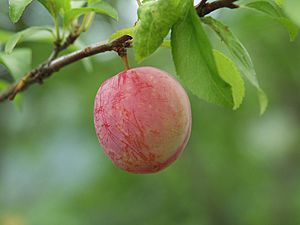Prunus salicina facts for kids
Quick facts for kids Prunus salicina |
|
|---|---|
 |
|
| Conservation status | |
| Scientific classification | |
| Genus: |
Prunus
|
| Species: |
salicina
|
| Synonyms | |
|
|
The Japanese plum or Chinese plum is a small tree known by its scientific name, Prunus salicina. It is originally from China. This tree is special because it loses its leaves every year.
Today, you can find Japanese plum trees growing in many countries. These include Vietnam, Korea, Japan, Israel, the United States, and Australia.
It's important not to mix up Prunus salicina with Prunus mume. Prunus mume is another similar tree grown in China, Japan, Korea, and Vietnam. Also, Prunus japonica is a different type of tree, even though its name sounds a bit like the Japanese plum. A plant expert named Luther Burbank worked hard to mix Prunus salicina with other plum types. He created many new kinds of plums from these mixes.
Contents
What Does the Japanese Plum Look Like?
Prunus salicina trees can grow quite tall, up to 10 meters (about 33 feet). Their young branches have a reddish-brown color.
The leaves of the Japanese plum are about 6 to 12 centimeters (2.4 to 4.7 inches) long. They are also 2.5 to 5 centimeters (1 to 2 inches) wide. The edges of the leaves are jagged, like a saw.
In early spring, the trees produce beautiful flowers. Each flower is about 2 centimeters (0.8 inches) across. They have five white petals.
The fruit of the Japanese plum is called a drupe. This means it has a hard pit in the middle, like a peach or cherry. The fruit is usually 4 to 7 centimeters (1.6 to 2.8 inches) wide. It has yellow-pink flesh inside. You can pick the fruit in the summer. When it's fully ripe, you can eat it fresh.
Where Are Japanese Plums Grown?
Many different kinds of Prunus salicina are grown in China. Some of these are even mixed types, meaning they are a blend of different plum varieties.
Japanese plums are also very popular in Japan and Korea. In Vietnam, a famous type of this plum is called the Tam Hoa plum. It is grown in a town called Bắc Hà in Lào Cai Province.
In the late 1800s, Japanese plum types were brought to the United States. Here, plant breeders created many new kinds of plums. These new types often had larger fruits. Many American plums are a mix of Prunus salicina with other plum species like P. simonii and P. cerasifera. One well-known type is "Santa Rosa," named after a city in California.
Most fresh plums sold in North American stores are Prunus salicina types or mixes. These plums are grown in large amounts in many countries. For example, they are a very important crop in Western Australia.
How Are Japanese Plums Used?
Cooking and Food
In China, Japanese plums are made into candied fruits. These are preserved with sugar, salt, and liquorice for a special flavor.
In Japan, these plums are not eaten as much as Prunus mume. However, they are often pickled and colored in a similar way. At summer festivals, especially in Eastern Japan, you might find pickled plums covered in a sweet syrup called mizuame. This treat is called anzuame.
In both China and Japan, half-ripe plums are used to flavor a special drink. In Japan, this drink is called sumomo shu (すもも酒), which is a type of liqueur.
For more ways plums are used, you can check out the main plum article.
Traditional Medicine
The fruits of the Japanese plum are also used in Traditional Chinese medicine. Some types of Japanese plums, like the "Crimson Globe," are known to have antioxidants. Antioxidants can help protect your body's cells from damage.
Where Does the Name Come From?
The scientific name for the Japanese plum is Prunus salicina. The second part of the name, salicina, comes from a Latin word. This Latin word means "willow".
See also
 In Spanish: Ciruelo chino para niños
In Spanish: Ciruelo chino para niños







